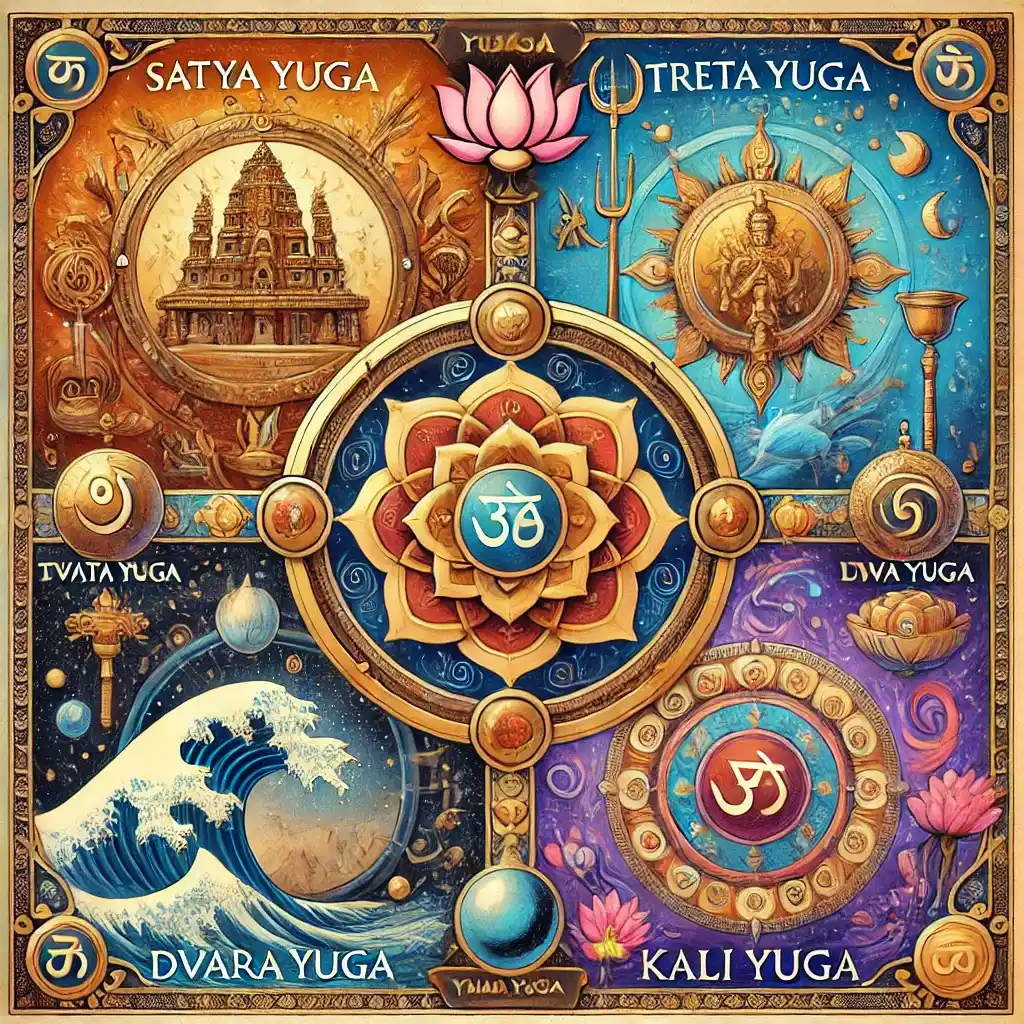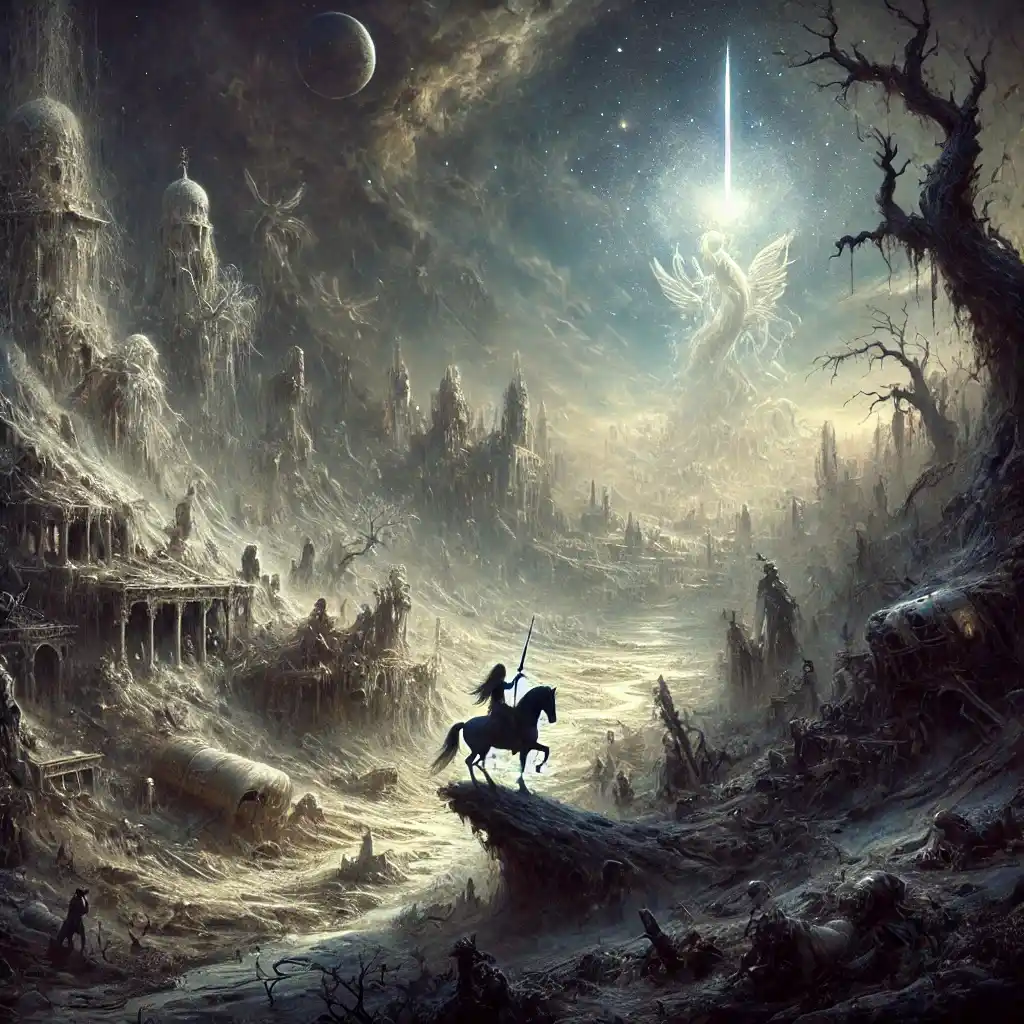
The Yugas
The Yugas
The Cycles of Time in Hindu Cosmology
In Hindu cosmology, time is understood as cyclical, divided into vast epochs known as Yugas. The concept of the Yugas offers a profound spiritual understanding of the universe’s cyclical nature, encompassing both physical and moral decline. The four Yugas—Satya Yuga, Treta Yuga, Dvapara Yuga, and Kali Yuga—represent different phases in the universe's life cycle, each characterized by specific spiritual, moral, and cosmic conditions.
Satya Yuga (Krita Yuga) - The Golden Age
Duration: 1,728,000 years
Characteristics: Satya Yuga is considered the age of truth and purity, where righteousness (Dharma) is fully intact. In this age, human beings are in their most elevated form, with the highest spiritual consciousness. There is no sorrow or pain, and life is in perfect balance. People are believed to live for thousands of years, experiencing the world in harmony with nature and divine principles.
Spiritual State: In Satya Yuga, people are closest to the divine, and meditation and self-realization are prevalent. There are no conflicts, and humanity exists in perfect harmony with itself and the cosmos. This era is often called the Golden Age due to its ideal state.
Treta Yuga - The Silver Age
Duration: 1,296,000 years
Characteristics: Treta Yuga marks a decline in the moral and spiritual state of the world, with Dharma losing one-quarter of its strength. It is also the era when the events of the Ramayana, including the story of Lord Rama, take place. In this Yuga, the average human lifespan is significantly reduced to about 1,000 years. However, people still lead virtuous lives, though not to the extent of the Satya Yuga.
Notable Events: This era is characterized by the emergence of the incarnations of Lord Vishnu, such as Vamana and Parashurama, who restore cosmic balance by defeating evil forces. Society starts to develop more complexities, including agriculture, and the concept of kingship becomes significant.
Dvapara Yuga - The Bronze Age
Duration: 864,000 years
Characteristics: In Dvapara Yuga, Dharma is reduced by half, and people begin to experience greed, jealousy, and other negative emotions more intensely. The world sees greater division, both socially and spiritually, leading to widespread conflict and strife. This is the era when the Mahabharata, including the teachings of the Bhagavad Gita, takes place.
Decline in Spirituality: The connection to the divine weakens, and rituals and sacrifices become more common as people rely less on direct spiritual experience and more on external religious practices. Human lifespans are further reduced to about 400 years.
Kali Yuga - The Age of Darkness
Duration: 432,000 years
Current Age: We are currently living in Kali Yuga, which is marked by widespread moral and spiritual degradation. Dharma is at its weakest, with only one-quarter of its original strength remaining. Greed, materialism, and corruption dominate this age, leading to conflict, suffering, and a decline in human values. The average human lifespan is reduced to around 100 years, with spiritual consciousness at its lowest ebb.
Significance of Kali Yuga: Although Kali Yuga is often associated with negative qualities, it is also a time when spiritual growth can be most impactful. The Bhagavad Gita suggests that in this dark age, devotion to God, particularly through simple practices like chanting and prayer, can lead to liberation (moksha). According to prophecy, Kali Yuga will end with the arrival of Kalki, the final avatar of Lord Vishnu, who will restore righteousness and begin the next cycle of creation, starting again with Satya Yuga.
The Cycle of Yugas (Mahayuga)
Each full cycle of the four Yugas is called a Mahayuga, which lasts for 4.32 million years. After each Mahayuga, the universe undergoes a period of dissolution (Pralaya) before the cycle starts anew with another Satya Yuga. These Yugas not only describe the temporal evolution of the cosmos but also symbolize the spiritual journey of human beings. As time progresses, there is a gradual decline in human virtues, which are restored at the end of Kali Yuga through divine intervention.
The Significance of Yugas in Modern Times
In the current era, many spiritual leaders emphasize the importance of practicing devotion and self-realization during Kali Yuga. According to Hindu scriptures, it is believed that even though Kali Yuga is fraught with challenges, the simplest forms of devotion can yield great spiritual progress. The accessibility of spiritual knowledge and practices during this time is considered a unique opportunity for individuals to reconnect with the divine.
Moreover, the Yugas offer a perspective on the larger cycles of human civilization. While we may perceive history as linear, the concept of the Yugas suggests that the rise and fall of civilizations, spiritual knowledge, and human virtue are part of a broader cosmic order.
Spiritual Practices for Kali Yuga
Despite the challenges of Kali Yuga, the scriptures recommend simple, accessible spiritual practices that can lead to personal growth and salvation:
Chanting and Devotion: Repeating the name of God (e.g., Hare Krishna mantra) is considered one of the most powerful tools for spiritual progress in this age.
Service and Charity: Acts of kindness and service to others can help individuals align with higher spiritual principles.
Meditation and Yoga: These practices allow individuals to connect with their inner self and the divine, providing a pathway to enlightenment even in challenging times.
Conclusion
The Yugas represent a deep, philosophical understanding of time and morality in Hinduism. By recognizing the cyclical nature of the universe, the concept of the Yugas offers insights into the human condition, spiritual progress, and the ultimate balance of righteousness and disorder in the world. While Kali Yuga may seem bleak, it also presents a unique opportunity for spiritual transformation, paving the way for a return to the golden age of Satya Yuga. As we navigate through these cycles, the timeless wisdom of the Yugas reminds us of our place within the cosmic order, encouraging us to pursue truth, righteousness, and spiritual growth.

Explore the intricate details of Dvapara Yuga, the third age in Hindu cosmology. Learn about its significance, key events like the Mahabharata war, the Bhagavad Gita, and how dharma transitioned in this era. Discover timeless spiritual lessons relevant to today's world in this in-depth, informative blog.

Explore the latest and most popular products available on Amazon, handpicked for your convenience! Whether you're shopping for tech gadgets, home essentials, fashion items, or something special, simply click the button below to view the product on Amazon. We’ve partnered with Amazon through their affiliate program, which means that if you make a purchase through this link, we may earn a small commission at no extra cost to you. This helps support our site and allows us to continue providing valuable content. Thank you for your support, and happy shopping!


